 |
 |
| 1915 | 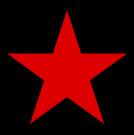 |
The US national insignia was placed upon the wings and fuselage.
The initial US Army Signal Corps aviation insignia used during the Pancho
Villa punitive expedition just before World War I, used on the vertical
tail and wings was a RED five-pointed star without a red or white outline
border.

One of the 1st Aero Squadron airplanes on the Mexican US border in 1916 marked on its rudder and wings with red stars as the US national insignia. The same style Red Star insignia was later adopted by the USSR. |
| 1918 | 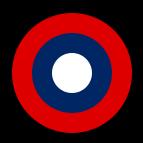 |
A tricolor roundel was introduced by the US Army Air Service in February 1918 for commonality with the other allies, all of whom used such roundels. Contemporary with the red star, the US Navy was using an anchor symbol on the rudders of its seaplanes. As of May 19, 1917 all branches of the US military were to use a white star with a central RED DOT all in a BLUE DISK painted in the official flag colors. In August 1919 the colors were adjusted to the current standards and the proportions were adjusted slightly so that the center dot was reduced slightly from being 1/3 of the diameter of the blue dot, to being bound by the edges of an imaginary pentagram connecting the inner points of the star. |
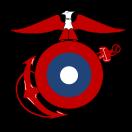 |
During the First World War and into the early post war period, US Marine Corps aircraft often had a WW1 style tri-color roundel with an anchor painted on the sides of the fuselage. | |
| 1919
|
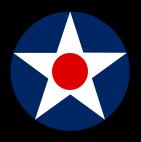 |
The insignia above was the US insignia in use from August of 1919 until the United States entered World War II. In the pre-WWII years, 1930-1941, the U.S. Military had some of the most colorful aircraft ever flown. "The Golden Age" as this period is sometimes referred to as, was a transitional period for military aircraft, advancing from Bi-Planes to single wing airplanes. |
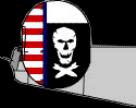 |
The paint scheme included high visibility Orange-Yellow paint on the upper wing surface of these aircraft (which was was expected to aid in search and rescue), along with painted tail sections (13 red & white horizontal stripes placed upon the tail rudder), fuselages, wing chevrons and belly bands added to the color of these planes. The skies over America were filled with these brightly colored aircraft, known as "Yellow-Wings", during the 1930's. This wasn't very practical from a modern military way of thinking, but it did reflect the times and the feeling of unrivaled dominance the U.S. Military thought it had achieved during this period. The Dec. 7th, 1941 Pearl Harbor Attack by the Japanese changed that sense of invulnerability. In the months after Pearl Harbor it was realized that the red dot could be construed as being a Japanese Hinomaru from a distance or in poor visibility and in May 1942 the red dot was eliminated. The red dots were covered over with white paint on aircraft that were in service. | |
| 1942 | 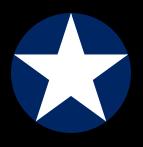 |
In January, the national insignia was added to both wings, top and bottom. The red dot in the center of the star was removed in the Pacific theater to eliminate confusion over the Japanese red disc which served as their insignia. The tail rudder stripes were also removed. These last two changes were accomplished throughout American forces by May of 1942. |
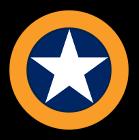 |
North Africa: During November 1942, US forces participated in the
Torch landings and for this a yellow ring (with varying thickness) was
temporarily added to the outside of the roundel to reduce incidents of
Americans shooting down unfamiliar British aircraft, which could themselves
be distinguished by a yellow outline on their fuselage roundels. The insignia
was outlined in yellow for Operation Torch in North Africa, to help gunners
distinguish it from the French roundel. It was later removed, except on
aircraft that remained in the North African theater.
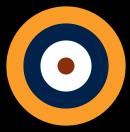 British
RAF Roundel British
RAF Roundel |
|
| 1943 | In February of 1943, one national insignia was removed from the upper right and lower left wing surfaces. Incidents of "friendly fire" continued after the "red dot" was removed, so the US Government initiated a study and discovered that the "red dot" wasn't the issue because color couldn't be discerned from a long distance anyway. Whereas shapes could. So the probable problem was the circular shape, which could be seen at distances. | |
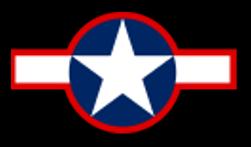 |
After trying out several variations including an oblong roundel
with two stars, they arrived at using white bars flanking the sides of
the existing roundel, all with a red outline, which became official in
June 1943. This still wasn't entirely satisfactory and the red was replaced
with blue in September 1943. On US Navy aircraft painted in gloss midnight
blue, the blue of the roundels was difficult to distinguish so the blue
portion was eventually dispensed with and only the white portion of the
roundel was painted on the aircraft.
June - September 1943: It was determined that the shape of the insignia was an important distinguishing feature, so a horizontal stripe was placed in the background with a thin red outline. |
|
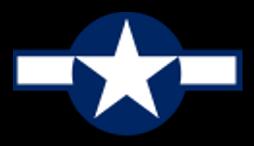 |
September 1943, to January 1947: the thin red outline was changed to blue. | |
| 1947
|
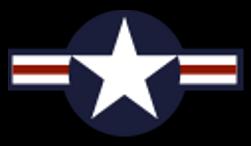 |
In January 1947 red bars were added within the existing white bars
on both USN and USAAF aircraft and in September of the same year, the United
States Army Air Forces (USAAF) became an independent service and was renamed
the United States Air Force (USAF).
In 1955 the USN (Navy) would repaint all its aircraft from midnight blue to light gray over white and would use exactly the same roundel as the USAF again. |
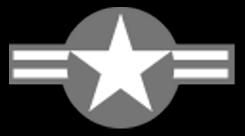 |
Since then there have been some minor variations, mostly having
to do with low-visibility versions of the star and bars roundel.
Air superiority F-15's eliminated the blue outline in the 1970s, and later some aircraft replaced the blue with black or a countershaded gray, or used a stencil to create an outlined version. |
|
| Enter your Email to join My Mailing List:
World War Two Squadron Patch List by: MessageBot |
![]()
Please don't pirate my pictures or text. Ask
my permission.
Copyright
© 1998-2012 Brian French. All Rights Reserved
Feel free to look at
these WW2 patches,
but please don't copy
my WWII Squadron Patch images without my permission.

|

|
|||
|
 |